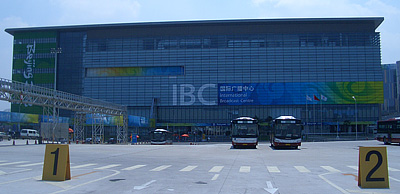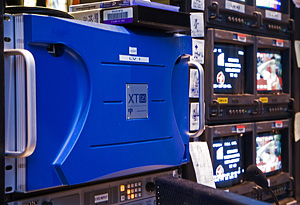BOB Goes All-HD
BEIJING

The main EVS server room in the BOB facility At the Olympics, host broadcaster Beijing Olympic Broadcasting (BOB) was in charge of the massive job of wrangling up enough HD equipment and personnel to manage the first Games to be broadcast entirely in HD.
And the job went beyond typical host duties because of those big fat 1080/50i signals.
The host broadcaster also had to do all the leg work to help rightsholders get all the fiber and HD transport equipment in place before the Games. Another major challenge was just finding enough HD broadcast trucks to meet venue needs.
SOLID-STATE GAMES
But the Beijing Games were more than just the first Olympics to be produced in HD. They were also the first where the host recording format was not tape. BOB used DVCPRO P2 HD equipment from Panasonic, including more than 100 camcorders, including solid-state P2 HD AJ-HPX3000 and AJ-HPX2000 2/3-inch 3-CCD models; 250 mobile and studio P2 HD recorders, including the AJ-HPM110 P2 Mobile; and about 1,500 production LCD monitors.

A Panasonic P2 in action This year marks the eighth consecutive Olympiad for which Panasonic has provided equipment in the official recording format for the Games.
BOB also partnered with EVS to make a popular lo-res service available to rightsholders. The system allowed users to find clips of the more popular sports through a lo-res browse station connected to an EVS ingest server room via Gigabit Ethernet. Requested full-res clips were then pushed to an XT in the rightsholder facility, where they could be accessed.
The idea was that by using proxies, broadcasters didn't have to record all the material they once did. In the past if a broadcaster wanted to air just a highlight of table tennis, it still had to record the full table tennis competition and then edit it.
With the new system, a smaller recording infrastructure was possible. If users subscribed to the BOB/EVS system, they could simply retrieve the table tennis clip without having to have recorded it themselves. They could edit it on an EVS XT server using EVS's IP Director basic editing software, which then pushes the hi-res edited clips back to the broadcaster.

Beijing Olympics Broadcasting's flashy digs The system saves rightsholders—particularly smaller rightsholders who may not have a lot of recording resources—from needing 20 or 30 VTRs. Now they only needed those recorders for events they want to show a big portion of, if they just needed snippets of an event they could rely on the EVS system.
But it wasn't just used by smaller broadcasters.
"We used it for a lot of our highlights for the cable outlets and for supporting the editors in New York who were putting together promo pieces," said David Mazza, senior vice president of engineering for NBC Olympics. "They didn't always have access to all of the recordings NBC made, but by using the system they could quickly retrieve a clip from a host feed and send it back to New York for promo production."
NBC also used the system for others who needed just short clips of host footage.
Get the TV Tech Newsletter
The professional video industry's #1 source for news, trends and product and tech information. Sign up below.

